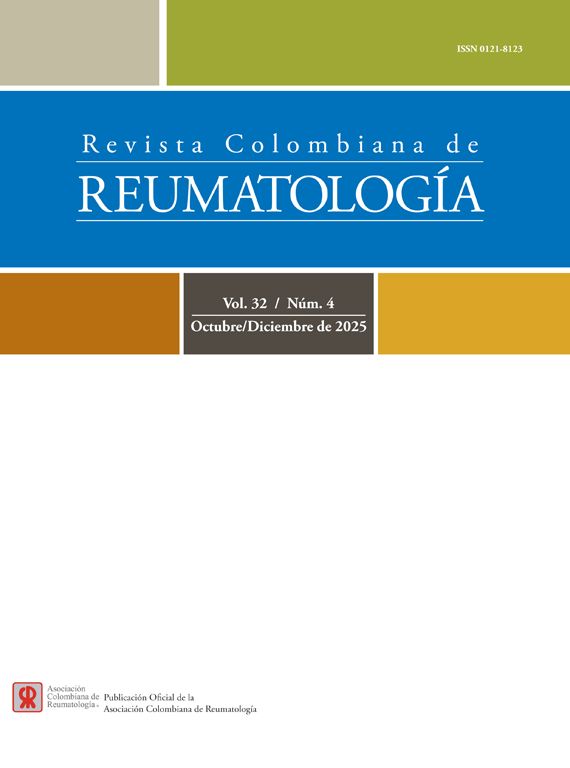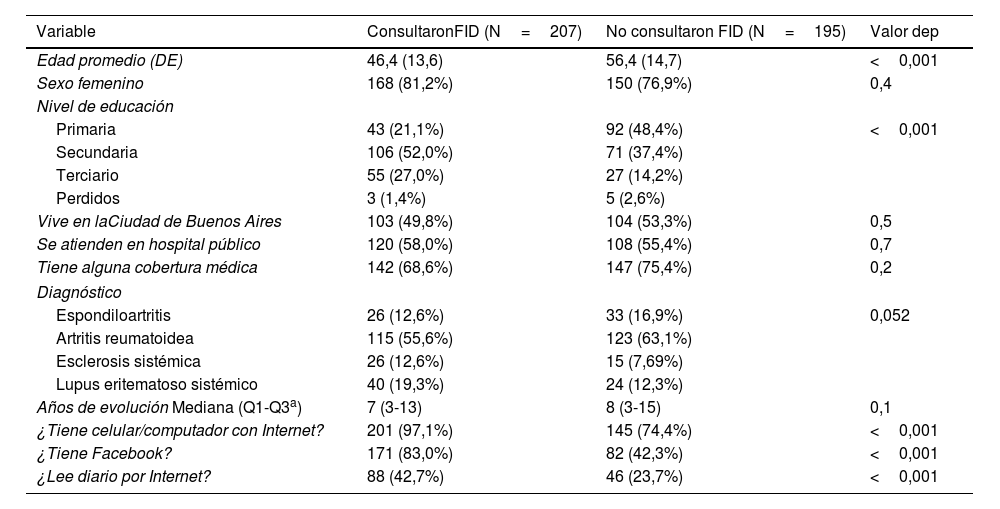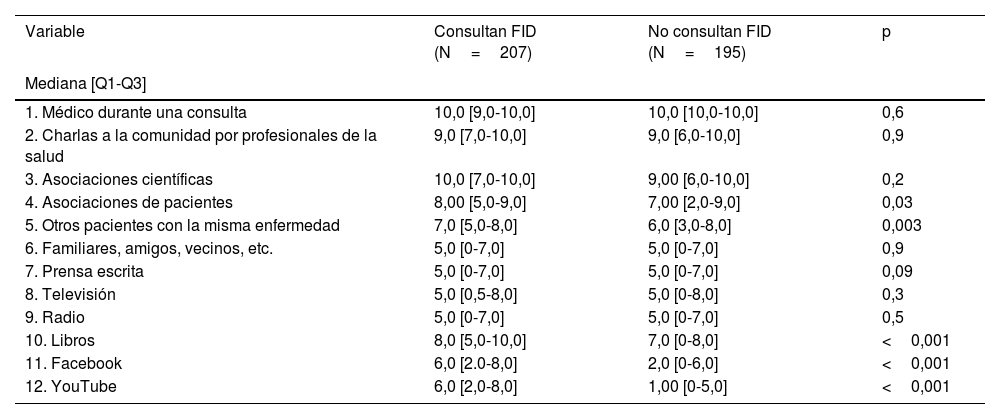Muchos pacientes utilizan Internet como fuente de información sobre salud y para crear y compartir contenidos con diferente calidad de evidencia, que complementan o incluso compiten con las fuentes tradicionales de información.
ObjetivosEvaluar diferencias entre pacientes reumáticos que consultan fuentes de información digitales (FID) y los que no lo hacen (no FID) y las percepciones sobre la credibilidad que ambos grupos adjudican a estas fuentes.
Materiales y métodosEstudio observacional, transversal, mediante una encuesta anónima, a pacientes con artritis reumatoide, lupus eritematoso sistémico, esclerosis sistémica y espondiloartritis. Se preguntó a los pacientes sobre la búsqueda de información en diferentes FID y no FID. Cada paciente calificó la credibilidad que adjudicaba a las diferentes fuentes, en una escala de 0 a 10, donde 0 es ninguna credibilidad y 10 el máximo de credibilidad posible.
ResultadosSe encuestó a 402 pacientes (79% mujeres). Hubo 207 pacientes (51%) que habían consultado, al menos, a una FID en el año previo grupo FID). El grupo FID había consultado en total 5 FID y no FID (primer-tercer cuartil: 3-7) vs. 2 (primer-tercer cuartil: 1-3) en el grupo no FID (p <0,001). Las consultas a una FID fueron mayores a menor edad (OR 0,97, IC del 95%, 0,95-0.99) y a mayor nivel de educación (secundario vs. primario OR 2,0; IC del 95%, 1,05-3,85). El grupo FID adjudicaba una mayor credibilidad a Facebook y YouTube que el resto (mediana de credibilidad de 6/10 y 6/10 vs. 2/10 y 1/10 respectivamente; p <0,001). Sin embargo, no adjudicaron una menor credibilidad que el resto a ninguna de las fuentes tradicionales.
ConclusionesLas FID son consultadas más frecuentemente por pacientes más jóvenes y que tienen un mayor nivel de educación. Estos pacientes consultan múltiples fuentes, pero no conceden una menor confianza a las fuentes tradicionales de información.
Many patients use the Internet as a source of health information and to create and share content of diverse quality of evidence, complementing and even competing with traditional sources of information.
ObjectivesTo evaluate differences between rheumatic patients who consult digital information sources (DISs) and those who do not (Non-DISs), and their perception of the credibility attributed to these sources by both groups.
Materials and methodsAn observational cross-sectional study was conducted through an anonymous survey of patients with rheumatoid arthritis, systemic lupus erythematosus, systemic sclerosis, and spondyloarthritis. Patients were asked about their search for information from different DISs or Non-DISs. Patients rated the credibility they assigned to the different sources on a scale of 0 to 10, where 0 was no credibility and 10 was the maximum possible credibility.
ResultsA total of 402 patients (79% female) were surveyed. Two hundred and 7(51%) had consulted at least one DIS during the previous year (DISs group). The DISs group had consulted a total of 5 DISs and Non-DISs (First-Third Quartile: 3-7) vs. 2 (First-Third Quartile: 1-3) in the Non-DISs group (p<.001). The number of searches in DISs was higher at younger ages (OR .97 95% CI .95-.99) and at higher levels of education (secondary vs. primary OR 2.0; 95% CI 1.05-3.85). The DISs group assigned higher credibility to Facebook and YouTube than the other patients (median credibility of 6/10 and 6/10 vs. 2/10 and 1/10 respectively; P<.001). However, they did not assign lower credibility to traditional sources.
ConclusionsDISs are more frequently consulted by a younger population with a higher level of education. These patients consult multiple sources, but do not assign lower credibility to traditional information sources.
Internet ha revolucionado el campo de la comunicación y la información de los pacientes. Según una encuesta de Instituto Nacional de Estadísticas de España, en el 2019 el 72% de la población buscó información sobre temas de salud en Internet1. El acceso universal a Internet y el uso de teléfonos inteligentes permiten a los pacientes acceder de manera fácil e instantánea (ya sea desde el hogar, el trabajo o incluso desde la vía pública) a una fuente inagotable de información2.
Según datos del 2019, en ese entonces había 450 millones de usuarios de Internet en Latinoamérica y el Caribe3, por lo que es previsible que las fuentes de información digitales (FID) terminen desplazando a los medios tradicionales de información como la televisión, la radio o la prensa escrita4,5.
Se ha observado una mejor evolución clínica, una mejor calidad de vida y un menor daño en los pacientes que reciben suficiente información sobre su condición y participan en la toma de decisiones con sus equipos médicos tratantes, especialmente aquellas relacionadas con las estrategias terapéuticas ofrecidas6.
Por otra parte, algunos autores han planteado que el acceso a fuentes de información mediante motores de búsqueda como Google (o, como muchas personas coloquialmente mencionan, «Dr. Google») puede traer como consecuencia que los pacientes lleguen sobreinformados o incluso «autodiagnosticados» a la consulta médica y que confronten el criterio clínico, menoscaben la credibilidad de la gestión del médico tratante y dificulten los procesos de diagnóstico y tratamiento7-9.
Por ello, se ha llevado a cabo el siguiente estudio, que tuvo como objetivo evaluar si existen características que diferencien a los pacientes que consultan FID de los que no lo hacen, y si hay diferencias en la credibilidad que ambos grupos de pacientes adjudican a las fuentes de información tradicionales, a las digitales y, en particular, a las que sus equipos médicos les proveen.
Materiales y métodosSe tomó una base de datos que hizo parte de un trabajo publicado en el año 202210, que tuvo por objetivo analizar la frecuencia de uso, intención de búsqueda y nivel de credibilidad de 12 fuentes de información seleccionadas en reumatología: información sobre la enfermedad dada por el médico durante la atención médica en el consultorio, charlas a la comunidad por profesionales de la salud, asociaciones científicas, organizaciones de pacientes, otros pacientes con la misma enfermedad, familiares, amigos o vecinos, prensa escrita, televisión, radio, libros, Facebook y YouTube.
Brevemente, se realizó una encuesta anónima, durante la consulta reumatológica a pacientes ambulatorios, mayores de 18 años, que tenían al menos seis meses de diagnóstico. Se optó por hacer las encuestas aprovechando la cita programada, para evitar pedir a los pacientes que regresaran en otra ocasión exclusivamente para completar la encuesta. No hubo otros criterios de inclusión/exclusión más allá de firmar el consentimiento informado y responder la encuesta.
Las encuestas fueron llevadas a cabo por los autores entre abril del 2019 y marzo del 2020. Se encuestó a pacientes con artritis reumatoide (AR), lupus eritematoso sistémico, esclerosis sistémica (ES) y espondiloartritis, incluyendo a pacientes con artritis psoriásica y espondilitis anquilosante.
Se preguntó si en el último año:
- 1.
Habían obtenido información sobre su enfermedad reumática en alguna de las 12 fuentes seleccionadas. Se pidió aclarar si habían consultado información sobre su enfermedad reumática en alguna otra fuente no identificada en la encuesta y, en ese caso, aclarar cuál había sido la fuente consultada.
- 2.
Cada paciente calificó la credibilidad que adjudicaba a las diferentes fuentes de información, en una escala de 0 a 10, donde 0 es ninguna credibilidad y 10 el máximo de credibilidad posible.
- 3.
Se preguntó a los pacientes sobre su intención de búsqueda, definida como el lugar donde les gustaría obtener información sobre su enfermedad reumática si quisieran hacerlo hoy.
Se dividió a los pacientes en dosgrupos, según si:
- 1.
Habían consultado, al menos, a una FID (grupo FID), que incluyeron: Facebook, YouTube y otras fuentes en Internet (Twitter, Google u otros buscadores).
- 2.
Solo habían consultado fuentes de información tradicionales (grupo no FID), que incluyeron: el médico durante la consulta, otros pacientes con la misma enfermedad, familiares, vecinos o amigos, asociaciones de pacientes con la misma enfermedad, charlas a la comunidad por profesionales de la salud, asociaciones científicas, prensa escrita, radio, televisión y libros.
Se recabaron datos demográficos, nivel de educación (1: primaria; 2: secundaria; 3 terciaria o universitaria), tiempo de evolución de la enfermedad en años, disponibilidad de computador o teléfono celular con acceso a Internet, participación en redes sociales y lectura de medios escritos digitales por Internet. Se registró si los pacientes tenían alguna cobertura de salud, si recibían prestaciones de salud de entidades financiadas por aporte y contribución obligatoria de trabajadores y empleadores, si eran atendidos en hospitales públicos o privados y además si habían sido encuestados en centros de salud de la Ciudad Autónoma de Buenos Aires o fuera de ella.
Análisis estadísticoSe llevó a cabo un análisis descriptivo de todas las variables, con frecuencia y porcentaje para las variables categóricas, mientras que para las continuas se utilizó la media con el desviación estándar o la mediana con el primer cuartil (Q1) y el tercer cuartil (Q3), según sea adecuado de acuerdo con la distribución de la variable. Las variables nominales en dosgrupos independientes se evaluaron con la prueba de la chi al cuadrado. Para comparar medias se utilizó la prueba de la t de Student. Las medianas se compararon mediante Mann-Whitney/Kruskal-Wallis. Se hicieron análisis univariados y multivariados: en el análisis multivariado «haber buscado información en FID» se consideró la variable de resultado. Un valor de p <0,05 fue considerado estadísticamente significativo. Para el análisis estadístico se utilizó Epi Info versión 7.2.5.0 y el software R (Epi Info™, http://wwwn.cdc.gov/epiinfo/).
Consideraciones éticasEl estudio fue aprobado por el comité de bioética y todos los pacientes firmaron consentimiento informado.
ResultadosResultados generalesSe encuestó a 402 pacientes, de los cuales 318 (79%) fueron mujeres y el resto hombres. Hubo 207 pacientes (51%) que habían consultado al menos a una FID en el año previo (grupo FID).
Como puede verse en la tabla 1, los pacientes que habían consultado FID eran más jóvenes y tenían un mayor nivel de educación. Los pacientes del Grupo FID tenían, en mayor proporción, teléfono o computador con acceso a Internet, una página de Facebook y leían medios escritos digitales con mayor frecuencia.
Características de los pacientes encuestados según si habían consultado fuentes de información digitales (FID) o no
| Variable | ConsultaronFID (N=207) | No consultaron FID (N=195) | Valor dep |
|---|---|---|---|
| Edad promedio (DE) | 46,4 (13,6) | 56,4 (14,7) | <0,001 |
| Sexo femenino | 168 (81,2%) | 150 (76,9%) | 0,4 |
| Nivel de educación | |||
| Primaria | 43 (21,1%) | 92 (48,4%) | <0,001 |
| Secundaria | 106 (52,0%) | 71 (37,4%) | |
| Terciario | 55 (27,0%) | 27 (14,2%) | |
| Perdidos | 3 (1,4%) | 5 (2,6%) | |
| Vive en laCiudad de Buenos Aires | 103 (49,8%) | 104 (53,3%) | 0,5 |
| Se atienden en hospital público | 120 (58,0%) | 108 (55,4%) | 0,7 |
| Tiene alguna cobertura médica | 142 (68,6%) | 147 (75,4%) | 0,2 |
| Diagnóstico | |||
| Espondiloartritis | 26 (12,6%) | 33 (16,9%) | 0,052 |
| Artritis reumatoidea | 115 (55,6%) | 123 (63,1%) | |
| Esclerosis sistémica | 26 (12,6%) | 15 (7,69%) | |
| Lupus eritematoso sistémico | 40 (19,3%) | 24 (12,3%) | |
| Años de evolución Mediana (Q1-Q3a) | 7 (3-13) | 8 (3-15) | 0,1 |
| ¿Tiene celular/computador con Internet? | 201 (97,1%) | 145 (74,4%) | <0,001 |
| ¿Tiene Facebook? | 171 (83,0%) | 82 (42,3%) | <0,001 |
| ¿Lee diario por Internet? | 88 (42,7%) | 46 (23,7%) | <0,001 |
En general, la cantidad de fuentes consultadas por los pacientes del grupo FID fue mayor: mediana de cinco fuentes de información (Q1-Q3: 3-7) vs. 2 (Q1-Q3: 1-3) en el resto (p <0,001).
Cuando se evaluó la intención de búsqueda y el nivel de credibilidad, estos también fueron mayores en los pacientes que habían consultado FID: mediana de 6 (Q1-Q3: 4-9) vs. mediana de 3 (Q1-Q3: 2-6) en el resto (p <0,001).
Análisis multivariadoEn la tabla 2 se presentan los resultados de las variables de manera conjunta y se concluye que la oportunidad de hacer una consulta en FID:
- -
Se reduce un 3% a medida que la edad del paciente aumenta en un año.
- -
Es mayor a mayor nivel de educación: es dos veces mayor para los pacientes que tenían nivel secundario con respecto a los pacientes con nivel primario y 2,5 veces mayor para los pacientes de nivel terciario, en comparación con los que tenían educación primaria.
- -
Es 75% menor si el paciente no tenía Facebook.
Los pacientes que habían consultado FID atribuían una mayor credibilidad a Facebook y a YouTube que el resto. Sin embargo, no tuvieron menor credibilidad que el resto en ninguna de las fuentes tradicionales. Por el contrario, tuvieron una credibilidad mayor en los libros, en «Otros pacientes con la misma enfermedad» y en «Organizaciones de pacientes con la misma enfermedad» (tabla 3). Particularmente, no se observaron diferencias, entre ambos grupos, en el nivel de credibilidad que adjudicaban al médico tratante, ni a las asociaciones científicas como fuente de información.
Nivel de credibilidad descrito por los encuestados de 12 fuentes de información seleccionadas, según si consultaron fuentes de información digitales (FID) o no
| Variable | Consultan FID (N=207) | No consultan FID (N=195) | p |
|---|---|---|---|
| Mediana [Q1-Q3] | |||
| 1. Médico durante una consulta | 10,0 [9,0-10,0] | 10,0 [10,0-10,0] | 0,6 |
| 2. Charlas a la comunidad por profesionales de la salud | 9,0 [7,0-10,0] | 9,0 [6,0-10,0] | 0,9 |
| 3. Asociaciones científicas | 10,0 [7,0-10,0] | 9,00 [6,0-10,0] | 0,2 |
| 4. Asociaciones de pacientes | 8,00 [5,0-9,0] | 7,00 [2,0-9,0] | 0,03 |
| 5. Otros pacientes con la misma enfermedad | 7,0 [5,0-8,0] | 6,0 [3,0-8,0] | 0,003 |
| 6. Familiares, amigos, vecinos, etc. | 5,0 [0-7,0] | 5,0 [0-7,0] | 0,9 |
| 7. Prensa escrita | 5,0 [0-7,0] | 5,0 [0-7,0] | 0,09 |
| 8. Televisión | 5,0 [0,5-8,0] | 5,0 [0-8,0] | 0,3 |
| 9. Radio | 5,0 [0-7,0] | 5,0 [0-7,0] | 0,5 |
| 10. Libros | 8,0 [5,0-10,0] | 7,0 [0-8,0] | <0,001 |
| 11. Facebook | 6,0 [2.0-8,0] | 2,0 [0-6,0] | <0,001 |
| 12. YouTube | 6,0 [2,0-8,0] | 1,00 [0-5,0] | <0,001 |
Q1: primer cuartil; Q3: tercer cuartil.
En este estudio se ha observado que los pacientes que consultan FID corresponden a un grupo de personas más jóvenes y con un nivel educativo superior. Si bien tienen una mayor confianza en las FID y consultan más fuentes de información en relación con su enfermedad que el resto, ello no implica que sientan una menor confianza en la información brindada por el médico durante la consulta ni en las fuentes tradicionales de información.
En un artículo de revisión publicado en el 2020 sobre el uso de redes sociales en reumatología, los autores reconocían que la discusión ya no era si se debía aceptar o no el uso de las FID, sino qué tan bien los médicos se adaptarían a ello11.
Según una publicación de la Liga Panamericana de Asociaciones de Reumatología (Panlar) del 2016, el 10% de todos los usuarios de Internet a nivel mundial pertenecen a Latinoamérica. Además, Facebook es la red social que cuenta con más usuarios en la región (más de 1,8 millones de usuarios), seguida por YouTube, que tiene 1,3 millones de usuarios12.
Diversos estudios analizaron los videos sobre enfermedades reumáticas publicados en YouTube.
En general, se ha reportado un nivel aceptable de calidad y confiabilidad de la información, que suele ser más alto en los videos generados por asociaciones académicas o instituciones profesionales. Sin embargo, los estudios publicados señalan que los pacientes deben ser alertados sobre la existencia en Internet de información engañosa o propaganda médica generada por particulares u organizaciones con fines de lucro13-22.
En un artículo publicado en el 2015 en torno a la educación de los pacientes con AR en Latinoamérica y el Caribe, se señaló que los pacientes de mayor edad no tenían la misma facilidad que los más jóvenes para el acceso a Internet y por ende debían diseñarse materiales educativos de acuerdo con sus necesidades. Además, si bien no se desaconsejó la publicación de videos educativos en YouTube, se sugirió la participación de equipos multidisciplinarios en la elaboración de los contenidos23.
Un estudio argentino publicado en el 2018, que se llevó a cabo con 496 pacientes con AR, informó que alrededor de un 20% de los pacientes recurría a Internet como fuente de información. Al igual que en este trabajo, los autores reportaron que los pacientes que recurrían a Internet tenían un promedio de edad significativamente menor24.
En un estudio realizado con 13.262 usuarios de redes sociales, se analizaron las publicaciones en línea sobre espondilitis anquilosante. Los usuarios podían ser pacientes o personas que proporcionaban apoyo o cuidados a individuos que necesitaban asistencia por dicha condición. La mayoría de los temas (60%) se centraron en discutir el tratamiento de la espondilitis anquilosante, mientras que los temas restantes abordaron cuestiones como el impacto psicológico, la literatura médica y las consecuencias de la enfermedad. Se observó que el 80% de los usuarios menores de 49 años utilizaban las redes sociales y este porcentaje aumentaba a medida que la edad disminuía25.
Con respecto a la educación, en una encuesta en línea a más de 400 pacientes con AR y osteoartritis, se encontró que a medida que el nivel de educación de los pacientes aumentaba, también aumentaba la búsqueda de información sobre su medicación26.
Este estudio tiene las siguientes limitaciones: dado que la encuesta se llevó a cabo aprovechando una consulta programada, aunque se tratara de una encuesta anónima, es posible que exista un sesgo en la opinión de los pacientes sobre su médico tratante. Además, si bien tanto las asociaciones científicas como las organizaciones de pacientes tienen modelos mixtos que incluyen también canales digitales (p. ej., Facebook y YouTube), se decidió analizarlas junto a las otras fuentes tradicionales.
Para llevar a cabo este estudio no se incluyó a pacientes con condiciones muy comunes en reumatología, como la osteoartritis y la osteoporosis, que afectan característicamente a pacientes de mayor edad.
En este trabajo los pacientes evaluaron 12 fuentes de información. Se deja para otras producciones científicas el análisis sistemático de la información contenida de cada fuente.
Como fortalezas, este estudio ha permitido la inclusión de más de 400 pacientes de distintas edades y nivel de educación, donde más del 85% tenía un computador o celular con acceso a Internet. Los pacientes que contestaron la encuesta presentaban 4 condiciones clínicas muy relevantes en la especialidad, como la AR, la artritis psoriásica, el lupus y la ES.
ConclusionesQue un paciente busque información en una FID no implica que tenga una menor confianza en sus médicos tratantes ni en las fuentes de información tradicionales. Por otra parte, si se desea difundir información científica a través de FID, debe considerarse que la población que accede con mayor frecuencia a estas fuentes tiende a consultar múltiples fuentes, son más jóvenes y tienen un mayor nivel de educación.
FinanciaciónNinguna.
Conflicto de interesesLos autores declaran que no tienen ningún conflicto de intereses.
Contribuciones de los autoresConceptualización y metodología: MPIG, PA y GS.
Recogida de datos de investigación: MPIG, PA, NF, JP, MEG, PP, MAS, VA, MEE, ML, MA, LGF,RH, DA, MLM, VLC, SFM, GS, EMK.
Curación, validación, administración y supervisión del proyecto: MPIG, PA y GS.
Recursos: GS, EMK.
Análisis formal: GS, MPIG, KR, JAB.
Redacción-elaboración borrador original: LA, MPP, GS, EMK.
Redacción, revisión y edición final: todos los autores escribieron el artículo, aprobaron el manuscrito final tal como se envió y aceptan ser responsables de todos los aspectos del trabajo.
Los autores desean agradecer a la profesora Ana Insausti por su colaboración en la traducción del resumen y a la Unidad de Investigación Clínica de la Sociedad Argentina de Reumatología (Unisar) por el asesoramiento con el estudio.







